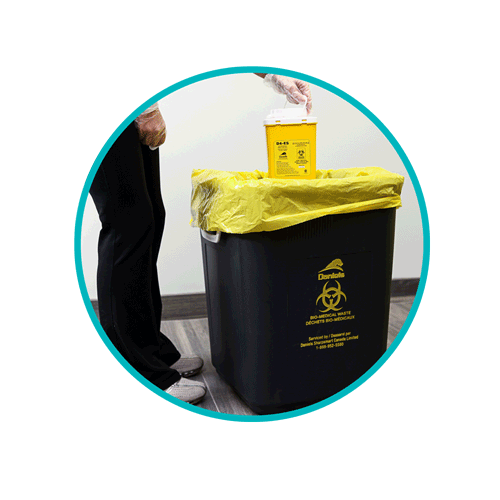Biomedical Waste Guidelines for Richmond, British Columbia

The city of Richmond, British Columbia is a municipality of Vancouver, located on its western coastline. The city’s diverse, agricultural and fishing industries provide jobs and livelihoods for the city’s roughly 200,000 residents. Healthcare services in the city of Richmond are equally diverse, from the 200-bed Richmond Hospital to outpatient services, dental and vision care providers, day surgeries, clinics, and on down to veterinary and funeral service providers.
Richmond – and the entire province of British Columbia – is dedicated to proper healthcare waste disposal processes. The Richmond city council and provincial government sites provide guidelines for such facilities to properly segregate, store, and dispose of their biomedical waste. While it isn’t always easy to find the regulations for certain aspects of biomedical waste management in Richmond or the province, resources are available if you are dedicated enough to look.
It is the responsibility of the medical waste generator, regardless of the size or type of facility, to know the rules regarding medical waste disposal, and even more importantly, how to deal with biomedical and/or hazardous waste.
TOPICS WE WILL COVER:
1 / Who's Making the Rules?
2 / Guidelines for Biomedical Waste Management
3 / Segregating and Organizing Biomedical Waste
4 / Biomedical Waste Treatment and Storage
 Who's Making the Rules
Who's Making the Rules
Canadian healthcare providers for humans or animals should be aware that several sources for governmental guidelines for proper medical waste segregation, storage, and disposal are available. The rules of the federal government, provincial governments, and city governments must all be followed. Note: Most provinces throughout Canada also have their own guidelines in regard to biomedical waste, such as the Management of Biomedical Waste in Ontario or Guidelines for the Management of Biomedical Waste in the Northwest Territories.
In British Columbia, agencies include the British Columbia Ministries of the Environment and Climate Change Strategy, the Ministry of health, and the greater Metro Vancouver Regional District, and a number of federal as well as national agencies. Keep in mind, however, that provincial and municipal entities, legislation or bylaws must adopt these guidelines to be enforceable. After that, local bylaws and regulations are often more strict than those recommended by the Canadian Council of Ministers of the Environment.
Don’t forget to review the Canadian Standards Association titled “Handling of Waste Materials in Healthcare Facilities and Veterinary Healthcare Facilities” (Standards CSA Z317.10).
Guidelines for Biomedical Waste Management

In British Columbia, become familiar with the Environmental Management Act, updated February, 2021. Chapter 53, Part 1 offers introductory provisions and definitions. How does this document define biomedical waste? According to the document, “biomedical waste” has the prescribed meaning. You need to dig a bit deeper to find exactly what that means. In the Canadian Biosafety Handbook, biomedical waste is “any kind of waste is generated through animal or human healthcare facilities as well as training and research facilities, research laboratories, and vaccine production facilities.”
We’ve dug a bit deeper for you.
What is Biomedical Waste?
In British Columbia, biomedical waste is determined to mean discarded materials from animals or humans, which, due to their source of nature may require specific treatment prior to disposal. Special biomedical waste can fall under seven types of biomedical waste sources, and include:
- Waste sharps
- Isolation wastes
- Waste human blood and blood products
- Waste cultures and stocks of infectious agents and associated biologicals
- Waste from surgeries and autopsies performed on patients and animals
- Wastes from patients and animals known to be infected by blood-borne diseases
- Waste contaminated animal carcasses, body parts, embedding
In British Columbia, nine primary waste categories are noted in documents, especially that of the Executive Summary. They include:
- Liquid human anatomical waste
- Solid human anatomical waste
- Infectious animal solid and liquid wastes
- Infectious biological wastes
- Infectious non-anatomical wastes (associated with patient care)
- Waste sharps
- Infectious microbiological wastes
- Chemical and pharmaceutical wastes
- Supplementary biomedical waste categories
Waste Segregation, Packaging and Labeling
As you can see, documents aren’t always particularly detailed. The government of British Columbia has produced a short, 15-page executive summary regarding handling of biomedical waste in British Columbia. It provides information regarding segregation, packaging, and labeling.
- For example, the document recommends, “that the compaction of packaged solid biomedical wastes destined for off-site treatment or disposal be discouraged or prohibited.”
- In regard to sharps, the document states, “Before disposal to a sanitary landfill, it is recommended that waste sharps be immobilized by solidification or destroyed by incineration, or grinding and disinfection.”
- About blood, blood products and other bodily fluids, the document states, “It is recommended that the disposal of small quantities of noninfectious blood, blood products and other bodily fluids to sanitary sewer systems be legally permitted. Sanitary sewer disposal of specified infectious blood and blood products, should be permitted after disinfection or sterilization.”
Yes, it is challenging for medical providers and facilities in Richmond, British Columbia to know exactly which rules to follow and where to find them. However, knowing the rules reduces your risk of fines or penalties for non-compliance.
Segregating and Organizing Biomedical Waste
Biomedical waste must be segregated from other medical waste streams and requires special treatment and handling. Biomedical waste is to be segregated at its origin into one of the following categories:
- Human anatomical waste
- Animal waste
- Human blood and bodily fluid waste
- Microbiological/laboratory waste
- Waste sharps
Some procedures might vary depending on the quantity of waste generated by any facility and access to equipment for treatment of medical waste.
Biomedical Waste Treatment and Storage

Any healthcare facility or provider in British Columbia is required to comply with quantity restrictions. Section 16.2 of the Canadian Biosafety Standards Guidelines focuses on the storage and disposal of biomedical waste. The section states how such waste is to be collected and stored. For example, “waste bags should be sealed, placed in leak-proof containers, and stored in a freezer, refrigerator, or cold room to await decontamination.”
Guidelines for sharps disposal is also specific. “Sharps waste is disposed of directly into a puncture-resistant container in accordance with the National Standard of Canada.” (National Standard of Canada/CSA Standard Z316.6-14 (Sharps injury protection – requirements and test methods – sharps containers.) Federal Canadian guidelines must always be followed. Each province, including British Columbia, also requires additional rules for biomedical waste management. Daniels understands that reviews are time-consuming and often confusing. However, compliance is vital in order to reduce the risk of damage to reputation, human health, or the environment.
Storage considerations and guidelines provided by the federal government might be less strict than those of British Columbia. In such cases, follow the guidelines of your province. If in doubt, consult British Columbia regulatory agencies for specific requirements depending on province and municipality. Do be aware that Canada’s biosafety standards also recommend limiting movement of waste disposal containers around areas of patient population and between medical departments in order to minimize the risk of exposure as well as release of any toxins or pathogens.
Penalties and fines are serious business in British Columbia. Any entity who fails to follow the guidelines for improper biomedical or hazardous medical waste (including packaging and improper container usage) can be fined up to $200,000 and possible jail time. Improper waste disposal can result in fines up to $1,000,000.
The Rules Matter
Daniels Health Canada knows federal and provincial laws and guidelines for the handling, storage, and disposal of biomedical waste. We can help you do your part to not only protect the environment but to enhance the safety of your employees, your patients, and the general public. For more information on how Daniels Health can help your facility stay on top of ever-changing guidelines and regulations, contact us today. Alternatively find out more about our Richmond operations and service capabilities on our Richmond service page here.
When it comes to healthcare waste segregation and management, don't take chances.
Call Daniels Health for help setting up a workable and safe healthcare waste management system
